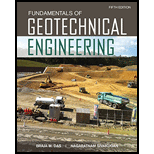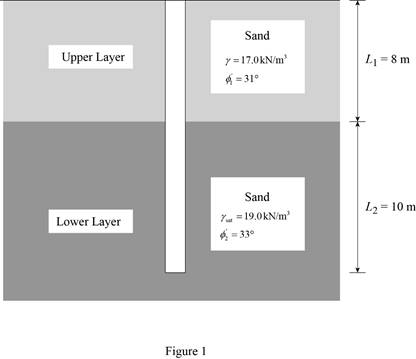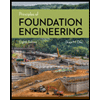
Concept explainers
Find the maximum allowable load on a driven pile.
Answer to Problem 18.6P
The maximum allowable load on a driven pile is
Explanation of Solution
Given information:
The diameter of the driven pile D is 450 mm.
The length of the pile in the upper layer of the sand
The unit weight of the upper layer sand
The soil friction angle in the lower layer of sand
The length of the pile in the lower layer of the sand
The saturated unit weight of the lower layer sand
The soil friction angle in the lower layer of sand
The soil-pile friction-angle
The coefficient value K is
The factor of safety
Calculation:
Draw the cross section of the pile as in Figure 1.

Calculate the earth pressure coefficient
Here,
Substitute
Calculate the coefficient K for the upper layer using the formula.
Here,
Substitute 0.485 for
Calculate the earth pressure coefficient
Here,
Substitute
Calculate the coefficient K for the lower layer using the formula.
Here,
Substitute 0.455 for
Calculate the area of pile
Substitute 450 mm for D.
Calculate the perimeter p of the pile using the formula.
Substitute 450 mm for D.
Refer Figure (18.12), “Meyerhof’s bearing capacity factor,
Take the value of bearing capacity factor
Calculate the load-carrying capacity
Here,
Take the unit weight of water as
Substitute
Check the calculated value of load-carrying capacity of the pile point using Meyerhof’s equation.
Substitute
Use the lowest of the calculated value of load-carrying capacity of the pile point.
Calculate the soil-pile friction-angle
Substitute
Calculate the soil-pile friction-angle
Substitute
Calculate the critical depth of the pile
Substitute 450 mm for D.
Calculate the unit frictional resistance at the upper layer of sand.
Consider 0 ft from top of the pile.
Calculate the magnitude of unit frictional resistance
Substitute 0 m for z.
The frictional resistance (skin friction)
Consider the pile to the depth of 6.75 m (critical depth of the pile) from the top of pile tip.
Calculate the magnitude of unit frictional resistance
Substitute 6.75 m for z, 0.727 for
Calculate the magnitude of unit frictional resistance
Substitute 6.75 m for z, 0.727 for
Below the upper layer
Calculate the frictional resistance (skin friction)
Substitute 1.414 m for p, 6.75 m for
Calculate the frictional resistance (skin friction)
Substitute 1.414 m for p, 6.75 m for
Calculate the frictional resistance (skin friction)
Substitute 1.414 m for p, 10 m for
Calculate the ultimate load on the pile
Substitute 146.51 kN for
Calculate the allowable load on the pile
Substitute 1,125.27 kN for
Therefore, the load carrying capacity of the pile is
Want to see more full solutions like this?
Chapter 18 Solutions
Fundamentals of Geotechnical Engineering (MindTap Course List)
- Figure 18.26a shows a pile. Let L = 20 m, D = 450 mm. Hf = 4m, f = 17.5 kN/m3, fill = 25. Determine the total downward drag force on the pile. Assume that the fill is located above the water table and that = 0.5 fill. FIG. 18.26 Negative skin frictionarrow_forwardRefer to Figure 18.9. A cantilever sheet pile is driven into a granular soil where the water table is 2 m (L1) below the top of the sand. The properties of the sand are =40, =17.5kN/m3, and sat=19kN/m3. It is proposed to excavate to a depth of 6 m (L) below the ground level. Determine the actual depth to which the sheet pile must be driven (L + D), using the net lateral pressure diagram. Note: Dactual=1.3(L3+L4)theoryarrow_forwardIn Problem 18.4, find the maximum bending moment in the sheet pile and determine the required section modulus, assuming an allowable stress of 190 MN/m2. 18.4 Refer to Figure 18.13. Given L1 = 1.5 m, L2 = 3 m; for the sand, =33, =16.5kN/m3, sat=19.0kN/m3; and, for the clay, c=50kN/m2, =0, sat=20kN/m3. Determine the depth of sheet pile required, allowing for a 50% increase from the theoretical estimate.arrow_forward
- Determine the maximum load that can be allowed on the 450 mm diameter pile shown in Figure 18.36, with a safety factor of 3. Use the a method for computing the shaft friction. FIG. 18.36arrow_forwardRefer to Figure 18.26b. Let L = 15.24 m, fill = 17.29 kN/m3, sat(clay) = 19.49 kN/m3, clay = 20, Hf = 3.05 m, and D = 0.406 m. The water table coincides with the top of the clay layer. Determine the total downward drag on the pile. Assume that = 0.6 clay. FIG. 18.26 Negative skin frictionarrow_forwardDetermine the maximum load that can be allowed on a 450 mm diameter driven pile shown in Figure P12.6, allowing a factor of safety of 3. Use K = 1.5 Ko and = 0.65 in computing the shaft load. Use Meyerhofs method for computing the point load.arrow_forward
- A 600 mm diameter and 25 m long driven concrete pile carries a column load of 1200 kN. It is estimated that the shaft carries 900 kN and the point carries 300 kN. Determine the settlement of the pile head using the Poulos and Davis method with the following data: Es = 25 MN/m2, Ep = 30,000 MN/m2, and s = 0.2arrow_forwardRefer to Figure 18.13. Given L1 = 1.5 m, L2 = 3 m; for the sand, =33, =16.5kN/m3, sat=19.0kN/m3; and, for the clay, c=50kN/m2, =0, sat=20kN/m3. Determine the depth of sheet pile required, allowing for a 50% increase from the theoretical estimate.arrow_forwardConsider a 500 mm diameter pile having a length of 18 m in a clay. Given: γ = 20.0 kN/m3 and cu = 60 kN/m2. Determine the maximum allowable load (Qall) with FS = 3. Use the α method and Table 12.11 for determining the skin friction and Eq. (12.20) for determining the point load. Allow a factor of safety of 3. What percentage of the ultimate load is being carried by the pile shaft? Is it a friction pile?arrow_forward
- Redo Problem 12.3 using Coyle and Castellos methods for estimating both Qp and Qs. 12.3 A 500 mm diameter and 20 m long concrete pile is driven into a sand where = 18.5 kN/m3 and = 32. Assuming = 0.7 and K = 1.5 Ko, determine the load-carrying capacity of the pile, with a factor of safety of 3. Use Meyerhofs method [Eq. (12.18)] for computing the point load-carrying capacity Qp, and Eqs. (12.42) and (12.43) for computing the load-carrying capacity of the pile shaft Qs.arrow_forwardFigure P12.36 shows a 3 5 pile group consisting of 15 concrete piles of 400 mm diameter and 12 m in length. What would be the maximum load that can be allowed on the mat with a factor of safety of 3? The piles have a center-to-center spacing of 1200 mm.arrow_forwardDetermine the maximum load that can be allowed on the 450 mm diameter pile shown in Figure P12.9, with a factor of safety of 3. Use the α method and Table 12.11 for determining the skin friction and Eq. (12.20) for determining the point load.arrow_forward
 Fundamentals of Geotechnical Engineering (MindTap...Civil EngineeringISBN:9781305635180Author:Braja M. Das, Nagaratnam SivakuganPublisher:Cengage Learning
Fundamentals of Geotechnical Engineering (MindTap...Civil EngineeringISBN:9781305635180Author:Braja M. Das, Nagaratnam SivakuganPublisher:Cengage Learning Principles of Foundation Engineering (MindTap Cou...Civil EngineeringISBN:9781337705028Author:Braja M. Das, Nagaratnam SivakuganPublisher:Cengage Learning
Principles of Foundation Engineering (MindTap Cou...Civil EngineeringISBN:9781337705028Author:Braja M. Das, Nagaratnam SivakuganPublisher:Cengage Learning Principles of Foundation Engineering (MindTap Cou...Civil EngineeringISBN:9781305081550Author:Braja M. DasPublisher:Cengage Learning
Principles of Foundation Engineering (MindTap Cou...Civil EngineeringISBN:9781305081550Author:Braja M. DasPublisher:Cengage Learning


